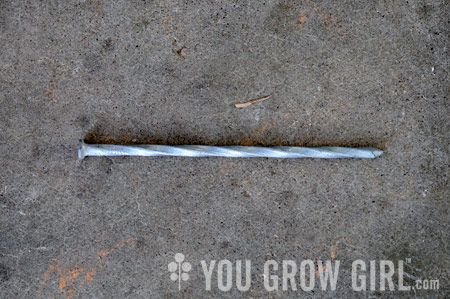
To the average person it’s just a gigantic, oversized nail, or a weapon of intimidation (who needs to carry a can of mace when you’ve got this up your sleeve, am I right?), but to me this is the perfect tool for making drainage holes in things that were not manufactured to function as plant pots.
A dremel or cordless drill, and a masonry bit is your best friend when it comes to making holes in terra cotta and ceramics, but a gigantic nail and a hammer is exactly what you need to effortlessly put holes into the bottom of recycled tin cans, metal buckets, busted watering cans, and creepy doll carriages.
Cost: $.89 brand new at my local hardware store. Or free if the roofing guys are slack and leave a bunch lying around where you could step on them and possibly develop tetanus. That’s how I acquired my previous giant nail. Fortunately, the part about stepping on the nail and developing tetanus is not true, but it COULD have happened.
One of my favorite garden accessories is a galvanized pail. I used my big nail to make holes it it. For a while it served as a planter, but it’s also been used to rinse pond pebbles. (They were dirty…)
Now, it’s hanging on a plant hook, serving as a catchall for trowels and hand cultivators and bits of wire, string, and big nails — stuff I might need. Since it has holes in it, the rain runs right out. I think Martha Stewart would be jealous.
I built houses for 20+ years and never saw “the roofing guys” using nails (or ‘spikes’) like the one in your picture. This type of nail/spike is used with pressure treated wood and landscape timbers.
Do you have any hints for drilling holes in pots not intended for plants?
I’ve tried the masonry bit trick with some success, but depending on the glaze on the pot, it doesn’t always work.
Daedre – Try a bit made for ceramic tile. Masonry bits are made for concrete and brick which are softer than high fire ceramic materials.
That’s a fine looking nail, Gayla, and I’m glad your sharp eye saw it before its sharp end contacted any part of your anatomy.
Ted, thank you for that tip. I have several ceramic-glazed terracotta pots without drainage holes. I’ve held back from drilling any holes because I though I might crack them. I’ll try a fine masonry bit. (I’m assuming that’s what you use, too, Gayla, but I’ll check your archives.)